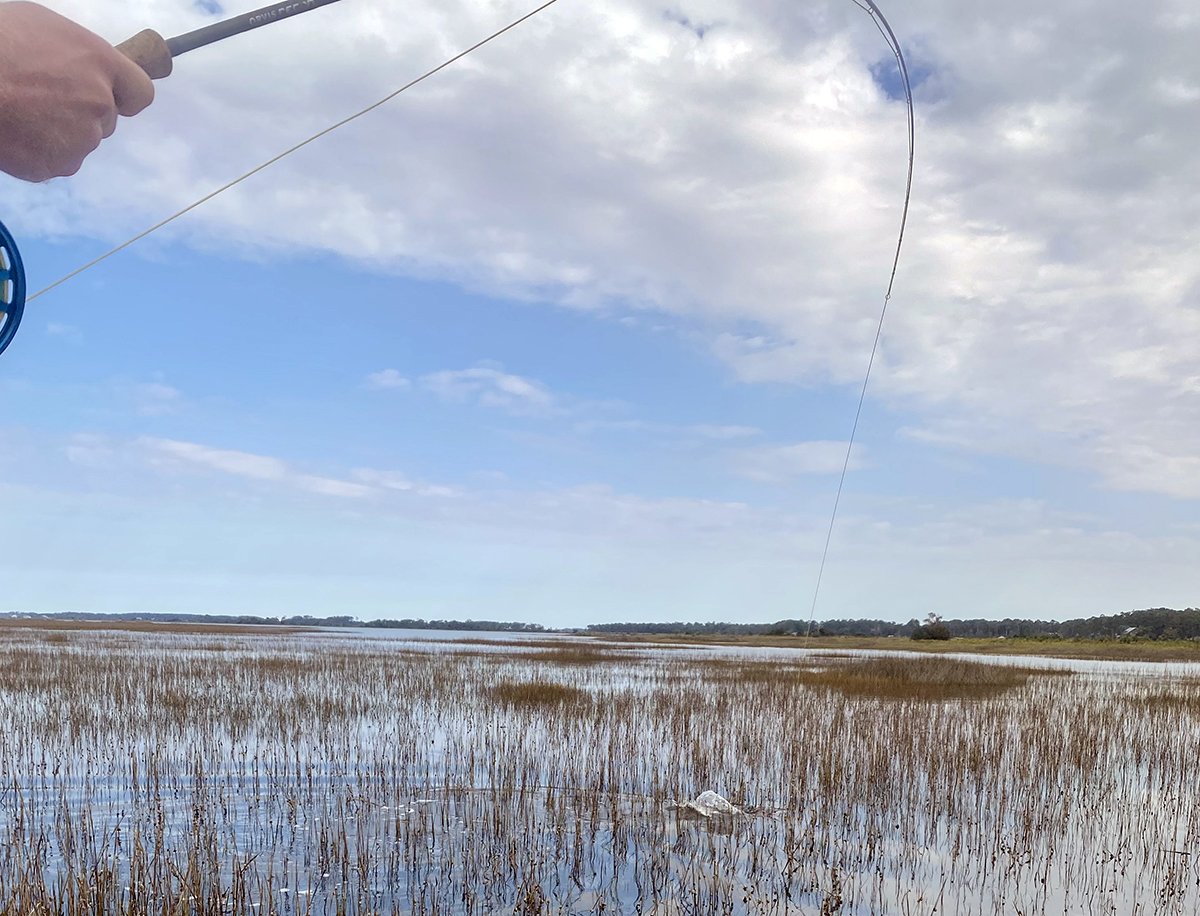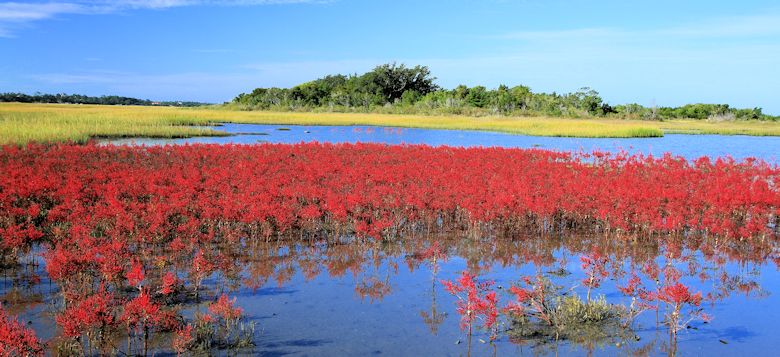
Glasswort is a type of plant known as a halophyte which can tolerate and thrive in areas with high salinity. Like these in Bogue Sound, they are one of first to show up in a protected tidal mud flat and create habitat for other species as well.
Supporter Spotlight
Almost every day, my travels take me up and over the high rise bridge that spans Bogue Sound and reaches over from the mainland to the western end of the barrier island known as Bogue Banks. The apex of the bridge yields one of the most beautiful sights along the North Carolina coast. A patch work of green Spartina marsh grass islands and small upland islands look like giant jig saw puzzle pieces that are floating among the tidal creeks and channels creating a maze-like landscape. From here, I always look to the west in an unconscious reflex to catch a glimpse of Bear Island, a remote beach lover’s paradise that quenches my thirst for the raw beauty of an unspoiled barrier island.
In late summer, as I summited the bridge, my gaze towards Bear Island was interrupted and stolen by a large blanket of red vegetation that was spread out in an open mud flat adjacent to a spoil island just west of the bridge. I was pretty sure I was familiar with the plant, but wanted to investigate since I have only seen a few of these plants in small clusters, never creating this appearance of a meadow.
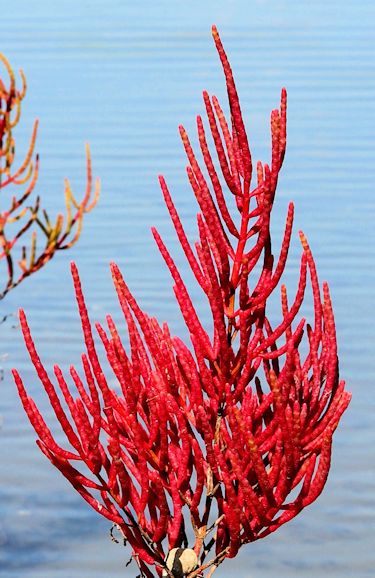 The new leaves of glasswort are green, and the red coloration is thought to be brought on by the buildup of salt in its plump stems as the plant matures. As an annual, it goes out in a blaze of glory. |
A few days later, I headed out in a twenty-two foot skiff that smoothly skimmed across the serene and placid waters on a windless day. As I set a westerly course along the channel of the Intracoastal Waterway, the smooth surface of the water was sliced open by the blade-like dorsal fin of a bottlenose dolphin. I slowed the boat and drifted along as a large pod methodically worked the water looking for fish. As each dolphin surfaced, the early morning silence was broken by the misty purging of air from its blowhole. A number of small young dolphins born this year could be seen sticking close to the side of an adult as if they were glued together. The seriousness of the group was broken from time to time as a few of the adults would leap completely out of the water and land with a showering splash. Reluctantly, I left the dolphins to go scout out the red plants, but I felt confident that they would still be around on the return trip.
As I passed under the shadow of the bridge, I began trimming the motor in anticipation of the shallow waters along the shore of the spoil island. With the boat securely anchored, I stepped into the knee deep warm water and waded up onto the bank of the island that was a small bluff of ancient oyster shells. The bluff was only about ten feet wide and the elevation dropped back down to a mud flat that looked like a cranberry bog. From ground level, the color of the red plants popped out against a backdrop of green marsh grass and maritime shrub thickets.
My suspicions about the plant were confirmed, glasswort plants had colonized this mucky mud flat that released an organic smell of rotted eggs after my foot falls disturbed the soil. The site was perfect for glasswort to thrive; it had the full beam of the sun all day long, was protected from the wave action of the waterway by the shell berm and was flooded with each high tide due to the low elevation on the backside of the island.
Supporter Spotlight
Glasswort is a type of plant known as a halophyte which can tolerate and thrive in areas with high salinity. There are close to 60 species that grow globally with a few of them, American, common and dwarf, found along the N.C. coast. They are collectively referred to as pickleweed, sea asparagus and in Europe as marsh samphire. These plants are a wetland
Photos by Sam Bland |
indicator species and are considered an obligate wetland species, which means that they will almost always occur in natural wetlands. These plants are one of first to show up in a protected tidal mud flat and create habitat for other species as well. This was evident by the presence of a white ibis stealthily prowling about in search of fiddler crabs. The presence of glasswort will eventually cause sediment to build up resulting in an elevation that will in turn be favorable for the pioneering of other plant species.
Out in the middle of this mud flat, almost all of the common glasswort plants were adorned with multiple periwinkle snails clinging to the base of their woody support stem. Each high tide will deposit a layer of algae and microbes on the glasswort stem that the periwinkle will consume by scraping away this biofilm with its rasp-like radula. The snails stop short of the fleshy scale-like leaves that have turned to a dark red color. The new leaves of this plant are green and the red coloration is thought to be brought on by the buildup of salt in its plump stems as the plant matures. As an annual, it goes out in a blaze of glory. The perennial American glasswort remains green throughout most of the year with the exception of red leaf tips that drop off from time to time.
Even though they have adapted to their salty environment, glasswort species do have a few defenses against the saline. Their roots are surrounded by a layer of oxygen that limits the amount of salt invasion and the tip of their segmented leaves will fall off to remove the highest concentration of salt. Their scientific Latin name, Salicornia, meaning “salty horn,” is a reference to their alkaline leaves. They also have thick waxy tubular leaves that curb the loss of fresh moisture in the plant from evaporation.
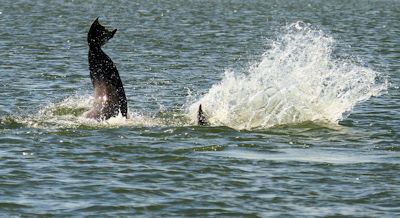 Bottlenose dolphin splash in the Intracoastal Waterway. |
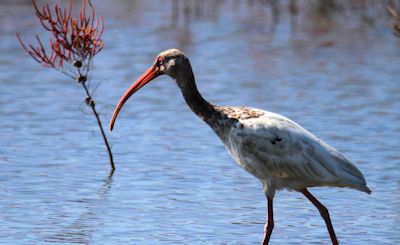 A white ibis hunts for fiddler crabs among the glasswort. |
Some people think that the name glasswort is attributed to their segmented leaves that break off “like glass” due to the salt content or when clumsily handled. Actually, the plant was used in the earliest methods of making glass. Large quantities of the plant were burnt to create an ash that was used in the making of glass. The ashes yield sodium carbonate from all the salt in the plant. When making glass, the sodium carbonate allowed the silica to melt at a lower temperature. Soap makers also used the glasswort ash to improve the cleaning power of their products. Glasswort is loaded with over thirty percent of unsaturated oil (twice that of soybeans) which has stimulated research into its use as a biofuel crop. Early studies have yielded almost 100 gallons of oil per acre of glasswort. It is also being studied as an animal feed, which isn’t surprising since I have seen white-tailed deer grazing on the plant in the marsh.
But this plant that resembles the texture of the foot of a goose, and is in the goosefoot family of plants, is probably best thought of as a food. The new tender shoots have been harvested for centuries to be eaten raw in salads or boiled or steamed as a side dish similar to asparagus. It’s good for you too, full of vitamins A, B and C as well as minerals calcium, iron and iodine. The plant has been used historically to treat pain and swelling related to arthritis and rheumatism and its antioxidant properties are being studied.
As I headed back to the boat dock, I wondered if other motorists had noticed the crimson colored patch of vegetation from the bridge and were curious as to what it was. It is these curiosities that keep me fascinated and intrigued with the mysteries of our coast.





